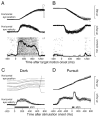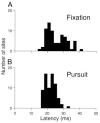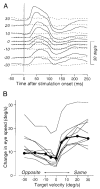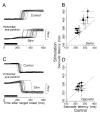Enhancement of multiple components of pursuit eye movement by microstimulation in the arcuate frontal pursuit area in monkeys
- PMID: 11826048
- PMCID: PMC2582524
- DOI: 10.1152/jn.00409.2001
Enhancement of multiple components of pursuit eye movement by microstimulation in the arcuate frontal pursuit area in monkeys
Abstract
Periarcuate frontal cortex is involved in the control of smooth pursuit eye movements, but its role remains unclear. To better understand the control of pursuit by the "frontal pursuit area" (FPA), we applied electrical microstimulation when the monkeys were performing a variety of oculomotor tasks. In agreement with previous studies, electrical stimulation consisting of a train of 50-microA pulses at 333 Hz during fixation of a stationary target elicited smooth eye movements with a short latency (approximately 26 ms). The size of the elicited smooth eye movements was enhanced when the stimulation pulses were delivered during the maintenance of pursuit. The enhancement increased as a function of ongoing pursuit speed and was greater during pursuit in the same versus opposite direction of the eye movements evoked at a site. If stimulation was delivered during pursuit in eight different directions, the elicited eye velocity was fit best by a model incorporating two stimulation effects: a directional signal that drives eye velocity and an increase in the gain of ongoing pursuit eye speed in all directions. Separate experiments tested the effect of stimulation on the response to specific image motions. Stimulation consisted of a train of pulses at 100 or 200 Hz delivered during fixation so that only small smooth eye movements were elicited. If the stationary target was perturbed briefly during microstimulation, normally weak eye movement responses showed strong enhancement. If delivered at the initiation of pursuit, the same microstimulation caused enhancement of the presaccadic initiation of pursuit for steps of target velocity that moved the target either away from the position of fixation or in the direction of the eye movement caused by stimulation at the site. Stimulation in the FPA increased the latency of saccades to stationary or moving targets. Our results show that the FPA has two kinds of effects on the pursuit system. One drives smooth eye velocity in a fixed direction and is subject to on-line gain control by ongoing pursuit. The other causes enhancement of both the speed of ongoing pursuit and the responses to visual motion in a way that is not strongly selective for the direction of pursuit. Enhancement may operate either at a single site or at multiple sites. We conclude that the FPA plays an important role in on-line gain control for pursuit as well as possibly delivering commands for the direction and speed of smooth eye motion.
Figures

















Similar articles
-
Role of arcuate frontal cortex of monkeys in smooth pursuit eye movements. II. Relation to vector averaging pursuit.J Neurophysiol. 2002 Jun;87(6):2700-14. doi: 10.1152/jn.2002.87.6.2700. J Neurophysiol. 2002. PMID: 12037172 Free PMC article.
-
Role of arcuate frontal cortex of monkeys in smooth pursuit eye movements. I. Basic response properties to retinal image motion and position.J Neurophysiol. 2002 Jun;87(6):2684-99. doi: 10.1152/jn.2002.87.6.2684. J Neurophysiol. 2002. PMID: 12037171 Free PMC article.
-
The role of the frontal pursuit area in learning in smooth pursuit eye movements.J Neurosci. 2004 Apr 28;24(17):4124-33. doi: 10.1523/JNEUROSCI.0172-04.2004. J Neurosci. 2004. PMID: 15115807 Free PMC article.
-
Predictive responses of periarcuate pursuit neurons to visual target motion.Exp Brain Res. 2002 Jul;145(1):104-20. doi: 10.1007/s00221-002-1088-7. Epub 2002 Apr 24. Exp Brain Res. 2002. PMID: 12070750
-
Eye movements: the past 25 years.Vision Res. 2011 Jul 1;51(13):1457-83. doi: 10.1016/j.visres.2010.12.014. Epub 2011 Jan 13. Vision Res. 2011. PMID: 21237189 Free PMC article. Review.
Cited by
-
The role of cortical areas hMT/V5+ and TPJ on the magnitude of representational momentum and representational gravity: a transcranial magnetic stimulation study.Exp Brain Res. 2019 Dec;237(12):3375-3390. doi: 10.1007/s00221-019-05683-z. Epub 2019 Nov 14. Exp Brain Res. 2019. PMID: 31728598
-
Different mechanisms for modulation of the initiation and steady-state of smooth pursuit eye movements.J Neurophysiol. 2020 Mar 1;123(3):1265-1276. doi: 10.1152/jn.00710.2019. Epub 2020 Feb 19. J Neurophysiol. 2020. PMID: 32073944 Free PMC article.
-
Control of the gain of visual-motor transmission occurs in visual coordinates for smooth pursuit eye movements.J Neurosci. 2013 May 29;33(22):9420-30. doi: 10.1523/JNEUROSCI.4846-12.2013. J Neurosci. 2013. PMID: 23719810 Free PMC article.
-
Discharge of pursuit-related neurons in the caudal part of the frontal eye fields in juvenile monkeys with up-down pursuit asymmetry.Exp Brain Res. 2009 Feb;193(2):181-8. doi: 10.1007/s00221-008-1606-3. Epub 2008 Oct 21. Exp Brain Res. 2009. PMID: 18936920
-
Role of arcuate frontal cortex of monkeys in smooth pursuit eye movements. II. Relation to vector averaging pursuit.J Neurophysiol. 2002 Jun;87(6):2700-14. doi: 10.1152/jn.2002.87.6.2700. J Neurophysiol. 2002. PMID: 12037172 Free PMC article.
References
-
- Burman DD, Bruce CJ. Suppression of task-related saccades by electrical stimulation in the primate’s frontal eye field. J Neurophysiol. 1997;77:2252–2267. - PubMed
-
- Carl JR, Gellman RS. Human smooth pursuit: stimulus-dependent responses. J Neurophysiol. 1987;57:1446–1463. - PubMed
-
- Churchland AK, Lisberger SG. Human smooth pursuit is subject to online gain control. Soc Neurosci Abstr. 2000;26(13):641.
Publication types
MeSH terms
Grants and funding
LinkOut - more resources
Full Text Sources

